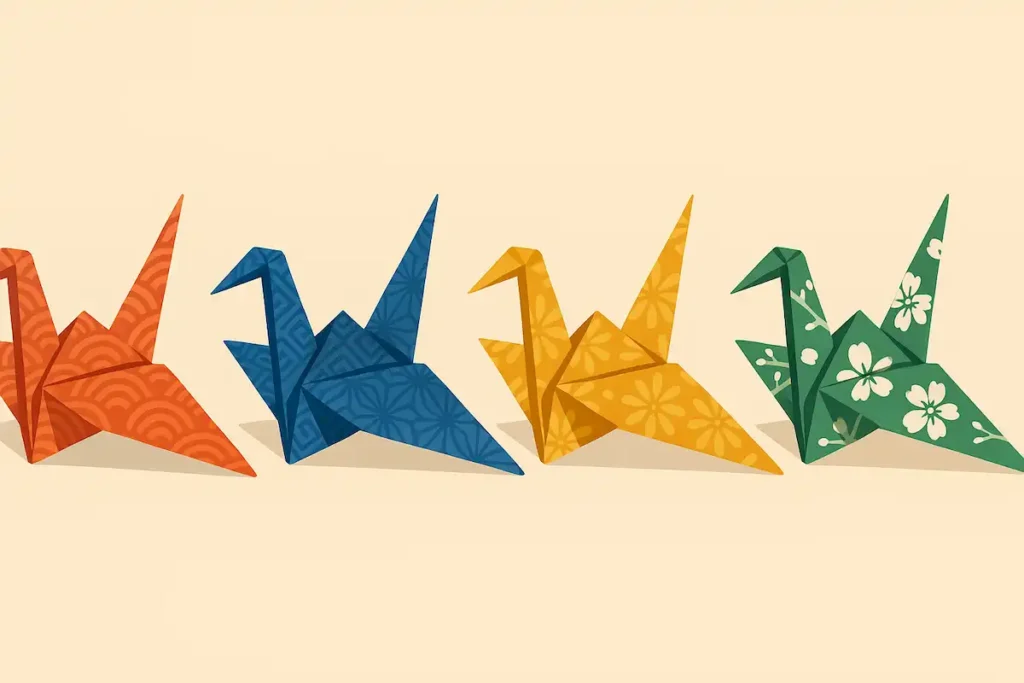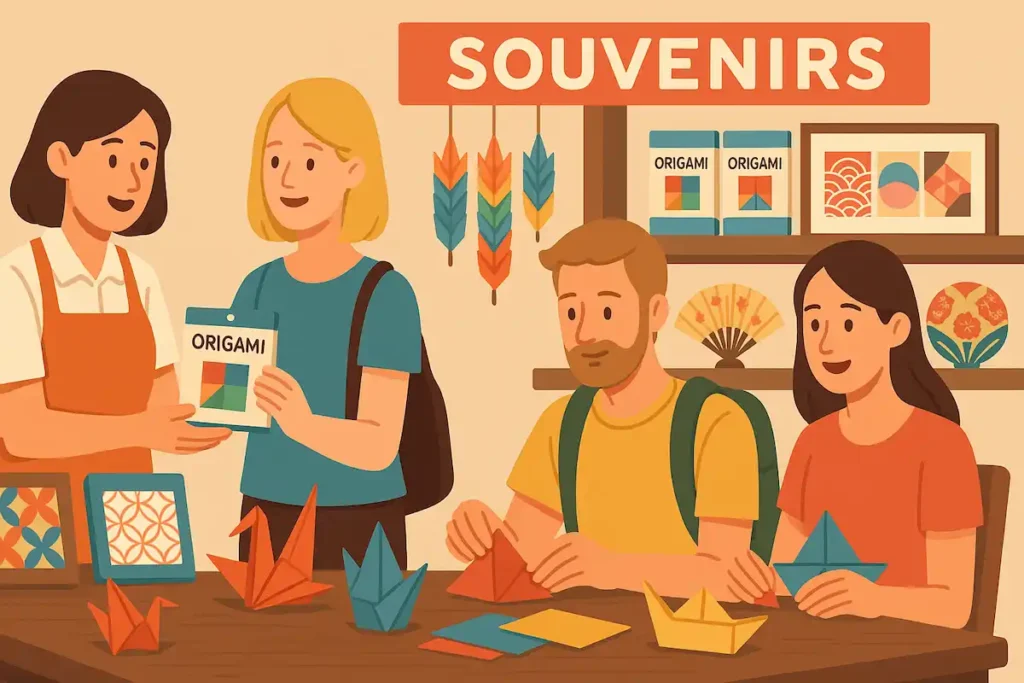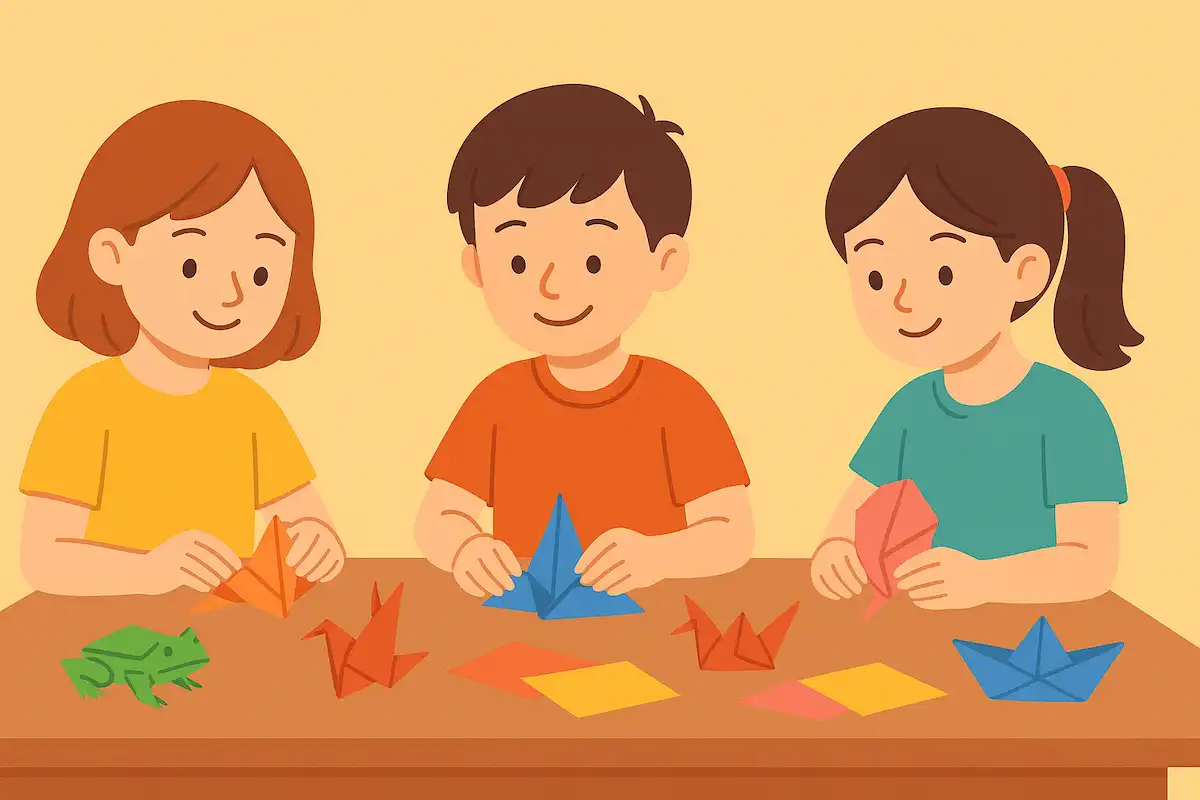折り紙を英語で説明・紹介するための基本情報と、英会話に役立つ表現をシンプルでわかりやすい英語で紹介します。
英会話ダイアローグ・概要・10の質問を通して、折り紙に関する英語表現を学びます。
英語
英会話ダイアローグを読む前に知っておくと良い前提知識と情報です。
- 基本知識
- 折り紙は「紙を折るだけ」で形を作る日本の伝統芸術
- ハサミや糊を使わず、正方形の紙一枚から作るのが基本
- 「折り紙(Origami)」は世界共通語になっている
- 歴史と文化
- 平安時代:儀式や贈答で紙を折る文化があった
- 江戸時代:庶民に広まり、遊びや教育として親しまれた
- 折鶴は平和と長寿の象徴で、千羽鶴は願いを込めて折られる
- 主な特徴
- シンプルさ:紙一枚で誰でも始められる
- 創造性:簡単な鶴や船から、昆虫や龍など複雑な作品まで可能
- 教育的効果:集中力・空間認識力・想像力を高める
- 現代的な広がり
- 科学技術:人工衛星のソーラーパネルや医療器具に応用
- 芸術:美術館や展覧会で展示される現代アート
- 国際性:世界中で折り紙協会やワークショップがある
- 実用情報
- 購入場所:文房具店、100円ショップ、土産物店、オンライン
- 価格帯:一般的なセットは100〜300円程度、高級和紙は数千円することもある
2人が折り紙について話しています。
折り紙の歴史や特徴、基本的な作り方から教育や科学への応用、現在の人気や購入方法などを話題にしています。
会話 / dialogue

Hey Key, I’ve been really curious about origami lately. Do you know much about it?

Of course! Origami is one of Japan’s most famous traditional arts. It’s all about folding a single sheet of paper into shapes.

That sounds simple, but is it really just paper? No scissors or glue?

Exactly. Traditionally, you only fold. That’s the beauty—creating so much from something so simple.

I’ve seen paper cranes before. Are they the most popular?

Yes, the crane is the most famous origami figure. It’s a symbol of peace and long life. People even fold a thousand cranes, called senbazuru, to make a wish.

Wow, that’s meaningful. I didn’t know it had such deep symbolism.

Origami often carries meaning. It’s not only art but also a way to express feelings, like prayers for peace.

When did origami start in Japan?

It goes back to the Heian period, when folded paper was used in ceremonies. Later, in the Edo period, it spread among ordinary people as play and education.

So it’s both cultural and educational. That’s impressive.

Exactly. Even today, children learn origami in school. It helps with concentration, hand skills, and imagination.

That explains why it’s still popular. Is origami also used in modern ways?

Definitely. Scientists use origami ideas for satellites, medical stents, and even building design.

That’s amazing—folding paper can inspire real technology.

Right. It shows how creativity can connect tradition with science.

Is origami only famous in Japan, or do people abroad practice it too?

It’s global now. “Origami” is an international word. There are associations, workshops, and exhibitions all over the world.

No wonder it’s so popular. But where do people usually buy origami paper here in Japan?

You can find it in stationery shops, 100-yen shops, and even souvenir stores. Prices range from a few hundred yen to several thousand for luxury washi paper.

I see. So it’s affordable for anyone but also has a luxury side.

Exactly. That balance makes it attractive for both children and adults, locals and tourists.

Personally, I’d love to try making something simple, like a boat or a hat.

Good idea. Those are perfect for beginners. Once you get used to folding, you can try more complex designs.

I can imagine it must be relaxing, almost like meditation.

Yes, many people say origami is calming. It’s one of those rare arts that are simple, creative, meaningful, and loved all around the world.
概要(折り紙とは?歴史・特徴・世界での広がり)
「折り紙」について、理解を深めるための「英語での概要」です。
折り紙

Introduction
Origami is the traditional Japanese art of folding paper into shapes. It uses only one sheet of paper, usually square, and does not need scissors or glue. With simple folds, people can create many figures, such as animals, flowers, boats, and boxes. The word “origami” comes from two Japanese words: ori meaning “to fold” and kami meaning “paper.” Today, origami is loved in Japan and also around the world.
History and Culture
The history of origami goes back to the Heian period (794–1185), when folded paper was used for ceremonies. Later, in the Edo period (1603–1868), origami became popular among ordinary people as play and education. The most famous origami figure is the paper crane, or orizuru. In Japanese culture, the crane is a symbol of peace and long life. Folding one thousand cranes, called senbazuru, is a way to make a wish or pray for health.
Features and Benefits
One reason origami is so attractive is its simplicity. Anyone can enjoy it with just a piece of paper. At the same time, it develops imagination and skill. Children learn origami in school to improve concentration, creativity, and hand movement. Adults also enjoy it as a hobby, and many people find it relaxing, almost like meditation.
Modern Uses and Popularity
Origami ideas are used in science and technology. Engineers design satellite panels, medical devices, and even buildings with origami structures. Origami is also seen in museums and art galleries as modern art. In Japan, people can buy origami paper in stationery shops, 100-yen shops, and souvenir stores, with prices from a few hundred yen to several thousand for luxury washi paper.
Conclusion
Origami is simple but meaningful. It is part of Japanese culture, a tool for education, an inspiration for science, and a hobby loved across the world. From children to adults, everyone can enjoy the beauty and creativity of origami.
10の質問(折り紙の基本知識)
「折り紙」について、理解を深めるための「英語での10の質問」です。
1: What is origami?
Origami is the Japanese art of folding paper into shapes like animals, flowers, and objects, usually without scissors or glue.
2: When did origami start in Japan?
Origami began in the Heian period for ceremonies and became popular among common people during the Edo period.
3: What is the most famous origami figure?
The paper crane, or orizuru, is the most famous. It is a symbol of peace and long life in Japan.
4: What is senbazuru?
Senbazuru means folding one thousand paper cranes. It is done to make a wish or pray for health and peace.
5: Why is origami attractive?
Origami is attractive because it is simple and creative. With one sheet of paper, people can make endless designs.
6: How does origami help children?
Origami helps children improve concentration, imagination, and hand skills. It is also used in schools.
7: How is origami used in modern science?
Scientists use origami ideas for satellite panels, medical devices, and even building design.
8: Is origami popular outside Japan?
Yes, origami is popular worldwide. The word “origami” is international, and many countries have clubs and exhibitions.
9: Where can people buy origami paper in Japan?
People can buy it in stationery shops, 100-yen shops, and souvenir stores, with prices from a few hundred yen to luxury washi paper.
10: Why do people enjoy origami today?
People enjoy origami because it is relaxing, meaningful, and brings people together across cultures and generations.

和訳付
会話 / dialogue

Hey Key, I’ve been really curious about origami lately. Do you know much about it?
ねえキー、最近折り紙にすごく興味があるんだ。詳しい?

Of course! Origami is one of Japan’s most famous traditional arts. It’s all about folding a single sheet of paper into shapes.
もちろん!折り紙は日本で一番有名な伝統芸術のひとつだよ。1枚の紙を折って、いろんな形を作るんだ。

That sounds simple, but is it really just paper? No scissors or glue?
簡単そうに聞こえるけど、本当に紙だけ?ハサミも糊もいらないの?

Exactly. Traditionally, you only fold. That’s the beauty—creating so much from something so simple.
その通り。伝統的には折るだけなんだ。それがすごいところで、シンプルなものからたくさん作れるんだよ。

I’ve seen paper cranes before. Are they the most popular?
紙の鶴は見たことあるよ。あれが一番有名なの?

Yes, the crane is the most famous origami figure. It’s a symbol of peace and long life. People even fold a thousand cranes, called senbazuru, to make a wish.
そうそう、鶴が一番有名だね。平和と長寿の象徴なんだ。千羽鶴っていって、願いを込めて千羽折ることもあるよ。

Wow, that’s meaningful. I didn’t know it had such deep symbolism.
へえ、意味が深いんだね。そんな象徴性があるなんて知らなかったよ。

Origami often carries meaning. It’s not only art but also a way to express feelings, like prayers for peace.
折り紙にはよく意味が込められているんだ。芸術だけじゃなくて、平和を祈る気持ちを表す手段でもあるんだよ。

When did origami start in Japan?
日本で折り紙っていつ頃始まったの?

It goes back to the Heian period, when folded paper was used in ceremonies. Later, in the Edo period, it spread among ordinary people as play and education.
平安時代までさかのぼるよ。当時は儀式に使われていて、そのあと江戸時代に庶民の遊びや教育として広まったんだ。

So it’s both cultural and educational. That’s impressive.
なるほど、文化的でもあり教育的でもあるんだね。すごいな。

Exactly. Even today, children learn origami in school. It helps with concentration, hand skills, and imagination.
そうだよ。今でも学校で子どもたちが習うんだ。集中力や手先の器用さ、想像力を育てるんだよ。

That explains why it’s still popular. Is origami also used in modern ways?
だから今も人気があるんだね。折り紙って現代でも使われているの?

Definitely. Scientists use origami ideas for satellites, medical stents, and even building design.
もちろん。科学者たちは人工衛星や医療用ステント、建築デザインにまで折り紙のアイデアを応用しているよ。

That’s amazing—folding paper can inspire real technology.
すごいね!紙を折ることが実際の技術に役立つなんて。

Right. It shows how creativity can connect tradition with science.
そうなんだ。創造力が伝統と科学をつなげるってことだね。

Is origami only famous in Japan, or do people abroad practice it too?
折り紙って日本だけ有名なの?それとも海外でもやる人いる?

It’s global now. “Origami” is an international word. There are associations, workshops, and exhibitions all over the world.
今は世界的だよ。「Origami」って国際的な言葉になっていて、世界中に協会やワークショップ、展示会があるんだ。

No wonder it’s so popular. But where do people usually buy origami paper here in Japan?
だから人気なんだね。でも日本ではどこで折り紙を買うの?

You can find it in stationery shops, 100-yen shops, and even souvenir stores. Prices range from a few hundred yen to several thousand for luxury washi paper.
文房具屋とか100円ショップ、あとお土産屋さんでも買えるよ。値段は数百円から、高級和紙だと数千円するものもあるね。

I see. So it’s affordable for anyone but also has a luxury side.
なるほど、誰でも手軽に買えるけど、高級品もあるんだね。

Exactly. That balance makes it attractive for both children and adults, locals and tourists.
そうそう。そのバランスが、子どもから大人まで、日本人も観光客も楽しめる理由なんだよ。

Personally, I’d love to try making something simple, like a boat or a hat.
僕も個人的に、船とか帽子みたいな簡単なやつを作ってみたいな。

Good idea. Those are perfect for beginners. Once you get used to folding, you can try more complex designs.
いいね。初心者にはぴったりだよ。慣れてきたらもっと複雑なデザインにも挑戦できるし。

I can imagine it must be relaxing, almost like meditation.
想像するだけで癒されそうだね。まるで瞑想みたい。

Yes, many people say origami is calming. It’s one of those rare arts that are simple, creative, meaningful, and loved all around the world.
そうだね。折り紙は落ち着くって言う人が多いよ。シンプルで創造的で意味があって、世界中で愛されている稀有な芸術なんだ。
概要(折り紙とは?歴史・特徴・世界での広がり)
折り紙

Introduction
Origami is the traditional Japanese art of folding paper into shapes. It uses only one sheet of paper, usually square, and does not need scissors or glue. With simple folds, people can create many figures, such as animals, flowers, boats, and boxes. The word “origami” comes from two Japanese words: ori meaning “to fold” and kami meaning “paper.” Today, origami is loved in Japan and also around the world.
折り紙は、日本の伝統的な紙を折って形を作る芸術です。通常は正方形の紙1枚だけを使い、ハサミや糊は必要ありません。簡単な折り方で、動物、花、船、箱など多くの形を作ることができます。「折り紙」という言葉は、日本語の「折る」と「紙」から来ています。現在、折り紙は日本だけでなく世界中で愛されています。
History and Culture
The history of origami goes back to the Heian period (794–1185), when folded paper was used for ceremonies. Later, in the Edo period (1603–1868), origami became popular among ordinary people as play and education. The most famous origami figure is the paper crane, or orizuru. In Japanese culture, the crane is a symbol of peace and long life. Folding one thousand cranes, called senbazuru, is a way to make a wish or pray for health.
折り紙の歴史は平安時代(794–1185)にさかのぼり、当時は儀式で折った紙が使われていました。その後、江戸時代(1603–1868)になると、折り紙は庶民の遊びや教育として広まりました。最も有名な作品は折鶴(おりづる)です。日本文化において鶴は平和と長寿の象徴であり、千羽鶴を折ることは願いを込めたり健康を祈る方法として知られています。
Features and Benefits
One reason origami is so attractive is its simplicity. Anyone can enjoy it with just a piece of paper. At the same time, it develops imagination and skill. Children learn origami in school to improve concentration, creativity, and hand movement. Adults also enjoy it as a hobby, and many people find it relaxing, almost like meditation.
折り紙が魅力的な理由の一つは、そのシンプルさです。紙1枚だけで誰でも楽しめます。同時に、想像力や技術を育むことができます。子どもたちは学校で折り紙を学び、集中力や創造力、手の動きを養います。大人も趣味として楽しみ、多くの人が折り紙を瞑想のように心を落ち着ける活動だと感じています。
Modern Uses and Popularity
Origami ideas are used in science and technology. Engineers design satellite panels, medical devices, and even buildings with origami structures. Origami is also seen in museums and art galleries as modern art. In Japan, people can buy origami paper in stationery shops, 100-yen shops, and souvenir stores, with prices from a few hundred yen to several thousand for luxury washi paper.
折り紙のアイデアは科学や技術にも応用されています。エンジニアは人工衛星のパネルや医療器具、さらには建物を折り紙の構造で設計しています。折り紙は美術館やアートギャラリーでも現代芸術として展示されています。日本では文房具店、100円ショップ、お土産店などで折り紙を購入でき、価格は数百円から、高級和紙では数千円にのぼることもあります。
Conclusion
Origami is simple but meaningful. It is part of Japanese culture, a tool for education, an inspiration for science, and a hobby loved across the world. From children to adults, everyone can enjoy the beauty and creativity of origami.
折り紙はシンプルでありながら意味深いものです。日本文化の一部であり、教育の道具であり、科学の着想源であり、世界中で愛される趣味でもあります。子どもから大人まで、誰もが折り紙の美しさと創造性を楽しむことができます。
10の質問(折り紙の基本知識)
1: What is origami?
折り紙とは何ですか?
Origami is the Japanese art of folding paper into shapes like animals, flowers, and objects, usually without scissors or glue.
折り紙は、ハサミや糊を使わずに、紙を折って動物や花、物の形を作る日本の芸術です。
2: When did origami start in Japan?
折り紙は日本でいつ始まりましたか?
Origami began in the Heian period for ceremonies and became popular among common people during the Edo period.
折り紙は平安時代に儀式のために始まり、江戸時代には庶民の間で広まりました。
3: What is the most famous origami figure?
最も有名な折り紙の作品は何ですか?
The paper crane, or orizuru, is the most famous. It is a symbol of peace and long life in Japan.
折鶴が最も有名です。日本では平和と長寿の象徴です。
4: What is senbazuru?
千羽鶴とは何ですか?
Senbazuru means folding one thousand paper cranes. It is done to make a wish or pray for health and peace.
千羽鶴とは、一千羽の折鶴を折ることを意味します。願いを込めたり、健康や平和を祈るために行われます。
5: Why is origami attractive?
折り紙が魅力的なのはなぜですか?
Origami is attractive because it is simple and creative. With one sheet of paper, people can make endless designs.
折り紙はシンプルで創造的だから魅力的です。紙一枚から無限のデザインを作ることができます。
6: How does origami help children?
折り紙は子どもにどのように役立ちますか?
Origami helps children improve concentration, imagination, and hand skills. It is also used in schools.
折り紙は子どもの集中力、想像力、手先の器用さを高める助けになります。学校でも使われています。
7: How is origami used in modern science?
折り紙は現代の科学でどのように使われていますか?
Scientists use origami ideas for satellite panels, medical devices, and even building design.
科学者は折り紙のアイデアを人工衛星のパネルや医療器具、さらには建物の設計にも応用しています。
8: Is origami popular outside Japan?
折り紙は日本以外でも人気がありますか?
Yes, origami is popular worldwide. The word “origami” is international, and many countries have clubs and exhibitions.
はい、折り紙は世界中で人気があります。「Origami」という言葉は国際的に使われ、多くの国にクラブや展示会があります。
9: Where can people buy origami paper in Japan?
日本ではどこで折り紙用の紙を買えますか?
People can buy it in stationery shops, 100-yen shops, and souvenir stores, with prices from a few hundred yen to luxury washi paper.
文房具店、100円ショップ、お土産屋で買えます。価格は数百円から、高級和紙では数千円するものもあります。
10: Why do people enjoy origami today?
人々はなぜ今も折り紙を楽しむのですか?
People enjoy origami because it is relaxing, meaningful, and brings people together across cultures and generations.
折り紙はリラックスでき、意味があり、文化や世代を超えて人々をつなぐため、人々は楽しんでいます。

words & phrases
英会話ダイアローグと関連情報に出てきた単語・フレーズです(例文は各3つ)。

fold : 動詞・名詞 /foʊld/
意味: 折る、折り畳む。To bend or crease something, usually paper or cloth, so that one part lies flat on another.
(折り紙で紙を折って形を作ることを表す)
例文:
- We fold the paper to make a crane.
「鶴を作るために紙を折ります。」 - Please fold the letter and put it in the envelope.
「手紙を折って封筒に入れてください。」 - The chair can fold for easy storage.
「その椅子は簡単に収納できるように折り畳めます。」
glue : 名詞・動詞 /ɡluː/
意味: 糊、接着剤。または糊で貼る。A sticky substance used to attach things together; to fasten with glue.
(折り紙では使わない道具として説明される)
例文:
- You don’t need glue to make origami.
「折り紙を作るのに糊は必要ありません。」 - The kids used glue for their craft project.
「子どもたちは工作で糊を使いました。」 - She glued the broken pieces together.
「彼女は壊れた部分を糊で貼り合わせました。」
meaningful : 形容詞 /ˈmiː.nɪŋ.fəl/
意味: 意味のある、価値のある。Having importance, purpose, or deep value.
(折鶴や千羽鶴のように、祈りや願いが込められていることを指す)
例文:
- Folding a thousand cranes is a meaningful tradition in Japan.
「千羽鶴を折ることは日本の意味深い伝統です。」 - His advice was very meaningful to me.
「彼の助言は私にとってとても意味がありました。」 - They shared a meaningful conversation.
「彼らは意義のある会話をしました。」
affordable : 形容詞 /əˈfɔːr.də.bəl/
意味: 手頃な価格の。Reasonably priced; not too expensive.
(100円ショップや文房具店で買える折り紙の値段を表す)
例文:
- Origami paper is very affordable in Japan.
「折り紙の紙は日本ではとても手頃です。」 - This restaurant is affordable for students.
「このレストランは学生にとって手頃です。」 - They sell clothes at affordable prices.
「その店は手頃な値段で服を売っています。」
symbolism : 名詞 /ˈsɪm.bə.lɪ.zəm/
意味: 象徴性、象徴的意味。The use of symbols to represent ideas or qualities.
(折鶴が平和や長寿の象徴であることを指す)
例文:
- The crane has strong symbolism in Japanese culture.
「鶴は日本文化で強い象徴性を持っています。」 - The color white carries symbolism of purity.
「白は純潔の象徴性を持っています。」 - His speech was full of symbolism.
「彼のスピーチは象徴性にあふれていました。」
